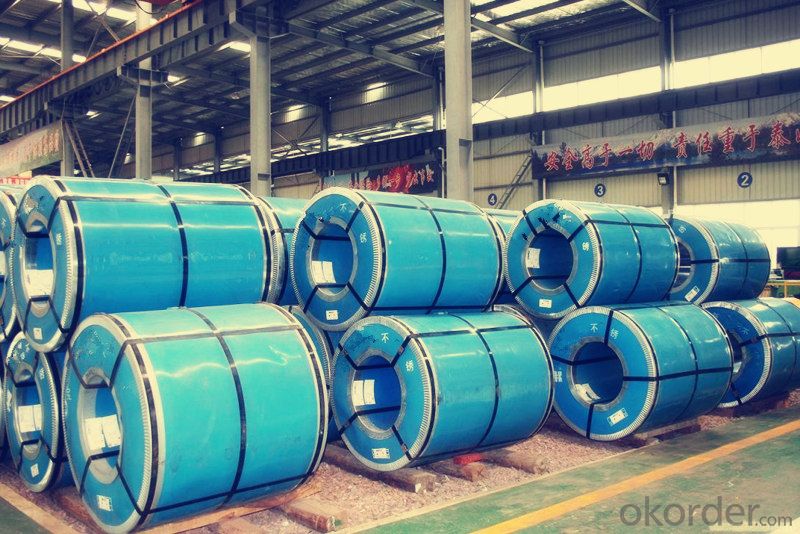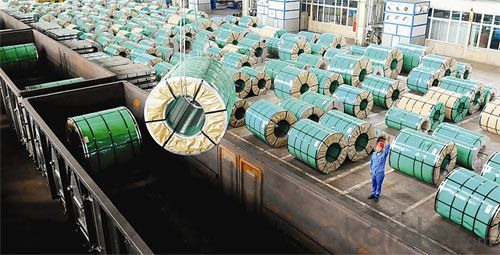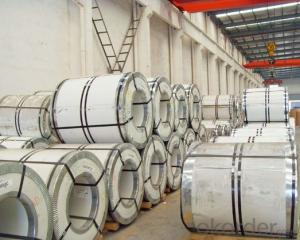2B / BA Finish 304 / 316 Stainless Steel Hot / Cold Rolled Coils Best Stock
- Loading Port:
- Tianjin
- Payment Terms:
- TT OR LC
- Min Order Qty:
- 20 m.t.
- Supply Capability:
- 3000 m.t./month
OKorder Service Pledge
OKorder Financial Service
You Might Also Like
Hot Rolled No.1 Finish Inox 304 Stainless Steel Coil / Sheet
Specification:
Thickness: 0.1mm-20mm;
Width: 400mm-3000mm;
Length: 1m-6m;
Standard:JIS,AISI,ASTM,GB,DIN,EN
Products information:
Thickness | 0.1mm-20mm |
Width | 400-3000mm or customized |
Length | 1m-6m or customized |
Standard | ASME, ASTM, EN, BS, GB, DIN, JIS, etc |
Material Grade | 300series |
Surface | 2B, BA, 8K, No. 4, HL, etc. |
Brand name | TISCO, LISCO , ZPSS, BAOSTELL , etc. |
Packaging | Standard export sea-worthy packing |
Technique | Hot rolled stainless steel sheet and coil or Cold rolled stainless steel sheet and coil |
Delivery time | 7-15 working days |
Supply ability | 3000 tons/ month |



- Q:What are the weight and length options for stainless steel strips?
- The weight and length options for stainless steel strips can vary depending on the specific requirements and specifications of the project or application. Stainless steel strips typically come in a range of thicknesses, widths, and lengths to cater to different needs. Common weight options for stainless steel strips range from light to heavy, with varying thicknesses and widths available. Similarly, the length options can vary from shorter lengths suitable for small projects to longer lengths for larger applications. It is important to consult with suppliers or manufacturers to determine the specific weight and length options available for stainless steel strips based on your requirements.
- Q:How do stainless steel strips handle exposure to chlorine?
- Stainless steel strips generally handle exposure to chlorine quite well. Chlorine is not usually corrosive to stainless steel, so the strips can withstand the effects of chlorine exposure without significant damage or degradation.
- Q:Can stainless steel strips be formed into coils or rolls?
- Yes, stainless steel strips can be formed into coils or rolls. Stainless steel strips are typically produced in coil form and can easily be wound into a coil or roll shape. This makes them convenient for transportation, storage, and further processing. The process of forming stainless steel strips into coils or rolls involves a combination of bending, coiling, and winding techniques, which allow for the creation of compact and tightly wound stainless steel coils. These coils or rolls can then be used in various applications such as manufacturing, construction, automotive, and many others. The ability to form stainless steel strips into coils or rolls adds to their versatility and makes them a popular choice in many industries.
- Q:How do stainless steel strips resist hydrogen-induced cracking?
- Stainless steel strips resist hydrogen-induced cracking due to their inherent composition and microstructure, which provide resistance against hydrogen embrittlement. The high levels of chromium and nickel present in stainless steel create a protective oxide layer on the surface, preventing hydrogen atoms from diffusing into the material. Furthermore, the fine grain size and increased ductility of stainless steel strips help to absorb and distribute hydrogen atoms, minimizing their detrimental effects and reducing the risk of cracking.
- Q:What is the weight of stainless steel strips?
- The weight of stainless steel strips can vary depending on their dimensions and thickness.
- Q:Can 111 stainless steel strips be coated with anti-corrosion coatings?
- Indeed, it is possible to apply anti-corrosion coatings to 111 stainless steel strips. Renowned for its corrosion resistance, stainless steel can be further safeguarded with the utilization of anti-corrosion coatings. These coatings establish a shield between the surface of the stainless steel and the encompassing atmosphere, effectively shielding against moisture, chemicals, and other destructive agents. Through the application of anti-corrosion coatings to the 111 stainless steel strips, their durability can be prolonged, enabling them to endure harsh conditions without succumbing to deterioration.
- Q:What are the common industry standards for stainless steel strips?
- The common industry standards for stainless steel strips vary depending on the specific application and requirements. However, there are several widely recognized standards that are commonly followed by manufacturers and users in the stainless steel industry. One of the most commonly referenced standards is the American Society for Testing and Materials (ASTM) standard. ASTM A666/A666M provides the standard specification for annealed or cold-worked austenitic stainless steel strips, which includes the chemical composition, mechanical properties, and dimensional tolerances for these materials. Additionally, the International Organization for Standardization (ISO) has several standards related to stainless steel strips. ISO 9445 specifies the tolerances on dimensions and form for continuously cold-rolled stainless steel narrow strip, while ISO 9444 provides general requirements for the preparation of steel substrates before application of paints and related products. In Europe, the European Committee for Standardization (CEN) has developed the EN standards for stainless steel strips. EN 10151 specifies the technical delivery conditions for cold-rolled stainless steel strip for springs, while EN 10088-2 covers the technical delivery conditions for stainless steel strip for general purposes. Apart from these widely recognized standards, there may be specific industry or application-based standards that are followed in certain sectors. These standards may outline additional requirements or specifications depending on the intended use of the stainless steel strips, such as in automotive, construction, or medical industries. It is important for manufacturers and users to be aware of the relevant industry standards and ensure compliance with these standards to ensure the quality, performance, and compatibility of stainless steel strips in their specific applications.
- Q:Are stainless steel strips easy to form and shape?
- Yes, stainless steel strips are relatively easy to form and shape due to their malleability and ductility. They can be easily bent, rolled, or manipulated into various desired shapes without losing their structural integrity.
- Q:What are the benefits of using stainless steel strips?
- Using stainless steel strips in various industries and applications offers numerous benefits. Firstly, stainless steel is renowned for its exceptional resistance to corrosion, making it an ideal choice for environments exposed to moisture, chemicals, or extreme temperatures. This corrosion resistance ensures that stainless steel strips have a longer lifespan and require less maintenance compared to other materials. Secondly, stainless steel strips provide high strength and durability. They can withstand heavy loads and resist deformation, making them perfect for applications that demand structural integrity and reliability. Whether it's for construction, automotive, or manufacturing purposes, stainless steel strips can meet the strength requirements of a wide range of industries. Thirdly, stainless steel is highly hygienic and easy to clean, making it suitable for applications in the food and medical industries. Its non-porous surface prevents the growth of bacteria, ensuring a safe and sanitary environment. Additionally, its smooth surface makes cleaning and maintenance effortless, saving time and effort in the long run. Moreover, stainless steel strips offer an aesthetically pleasing appearance. The material has a sleek and modern look that can enhance the visual appeal of various products and applications. This makes stainless steel strips a popular choice in architectural and interior design projects. Furthermore, stainless steel is a sustainable and environmentally friendly choice. It is fully recyclable, and using stainless steel strips helps reduce waste and minimize the need for new raw materials. The long lifespan of stainless steel also contributes to its sustainability, as it reduces the frequency of replacements and saves resources in the long term. In conclusion, the benefits of using stainless steel strips include corrosion resistance, high strength, hygienic properties, aesthetic appeal, and sustainability. These qualities make stainless steel strips a versatile and reliable material in various industries, providing long-lasting and cost-effective solutions.
- Q:What are the different cutting methods for stainless steel strips?
- There are several cutting methods for stainless steel strips, including shearing, laser cutting, waterjet cutting, and abrasive cutting. Each method has its own advantages and limitations, depending on factors such as the thickness of the strip, desired precision, and production volume.
1. Manufacturer Overview |
|
|---|---|
| Location | |
| Year Established | |
| Annual Output Value | |
| Main Markets | |
| Company Certifications | |
2. Manufacturer Certificates |
|
|---|---|
| a) Certification Name | |
| Range | |
| Reference | |
| Validity Period | |
3. Manufacturer Capability |
|
|---|---|
| a)Trade Capacity | |
| Nearest Port | |
| Export Percentage | |
| No.of Employees in Trade Department | |
| Language Spoken: | |
| b)Factory Information | |
| Factory Size: | |
| No. of Production Lines | |
| Contract Manufacturing | |
| Product Price Range | |
Send your message to us
2B / BA Finish 304 / 316 Stainless Steel Hot / Cold Rolled Coils Best Stock
- Loading Port:
- Tianjin
- Payment Terms:
- TT OR LC
- Min Order Qty:
- 20 m.t.
- Supply Capability:
- 3000 m.t./month
OKorder Service Pledge
OKorder Financial Service
Similar products
New products
Hot products
Related keywords































